Activation Process of ONU in EPON/GPON/XG-PON/NG-PON2 Networks
Abstract
:1. Introduction
2. Related Works
3. GPON and EPON Networks
- Class A: 5–20 dB
- Class B: 10–25 dB
- Class C: 15–30 dB
- MDI specifies the physical media and the mechanical and electrical interfaces between the transfer medium and the physical layer devices.
- PMD is responsible for linking to the transfer medium, and it is placed directly over the MDI. EPON uses WDM-based single-mode optical fibers. Two types of interfaces are supported, specifically: 1000BASE-PX10 with an overlapping distance of 10 km and 1000BASE-PX20 with an overlapping distance of 20 km.
- PMA provides functions for transmission, clock restart and phase alignment. This sublayer is primarily designed to specify the clock and data recovery (CDR) time interval.
- The physical coding sublayer (PCS) provides functions for link-coding of data (bits) that may be transmitted over the physical medium. EPON uses 8B/10B encoding [25].
- GMII specifies the interface between the media access control (MAC) layer and the physical layer.
- RS provides mapping of signals from GMII for the link layer.
4. xPON Activation Processes
4.1. GPON Activation States
4.2. XG-PON Activation Process
4.3. NG-PON2 Activation Process
4.4. EPON Activation Steps
5. Simulation Results
5.1. Simulations for ITU Standards
5.1.1. GPON
5.1.2. XG-PON
5.1.3. NG-GPON2
5.2. EPON
6. Conclusions
Author Contributions
Funding
Conflicts of Interest
Abbreviations
| ADSL | Asymmetric digital subscriber line |
| Alloc-ID | Allocation identifier |
| AMCC | Auxiliary management and control channel |
| APON | Asynchronous transfer mode passive optical network |
| BWmap | Bandwidth map |
| C-RAN | Cloud-radio access network |
| CDR | Clock and data recovery |
| DBA | Dynamic bandwidth allocation |
| DDSPON | Distributed dynamic scheduling passive optical network |
| EPON | Ethernet passive optical network |
| EqD | Equalization delay |
| FS | Framing sublayer |
| GMII | Gigabit media independent interface |
| GPON | Gigabit passive optical network |
| GTC | GPON transmission convergence layer |
| HEC | Hybrid error correction |
| IEEE | Institute of Electrical and Electronics Engineers |
| ISP | Internet services provider |
| ITU | International Telecommunication Union |
| LLID | Logical link identifier |
| MAC | Medium access control |
| MDI | Medium-dependent interface |
| MLM | Multi-longitudinal mode |
| MPCD | Multi-point control protocol |
| NG-PON2 | Next Generation Passive Optical Network Stage 2 |
| NRZ | Non-return-to-zero |
| LoF | Loss of frame |
| LoS | Loss of signal |
| ODN | Optical distribution network |
| OLT | Optical line termination |
| ONU | Optical network unit |
| ONU-ID | ONU identifier |
| ORL | Optical return loss |
| P2MP | Point to multipoint |
| PCBd | Physical control block downstream |
| PCS | Physical coding sublayer |
| PHY | Physical interface |
| PLOAM | Physical layer operations, administration and maintenance |
| PMA | Physical medium attachment |
| PMD | Physical medium dependent |
| PON | Passive optical network |
| PSBd | Physical synchronization block downstream |
| PSync | Physical synchronization |
| QoS | Quality of service |
| RS | Reconciliation sublayer |
| RTD | Round trip delay |
| SFC | Superframe counter |
| SLM | Single-longitudinal mode |
| TC | Transmission convergence |
| TWDM-TC | Time and wavelength division multiplexing transmission convergence |
| VHDL | Very High Speed Integrated Circuit Hardware Description Language |
| WDM | Wavelength-division multiplexing |
| WiFi | Wireless fidelity |
| XG-PON | Next generation passive optical network |
| XGTC | XG-PON transmission convergence layer |
| WLCP | Wavelength channel protection |
References
- Horvath, T.; Munster, P.; Vojtech, J.; Velc, R.; Oujezsky, V. Simultaneous transmission of accurate time, stable frequency, data, and sensor system over one fiber with ITU 100 GHz grid. Opt. Fiber Technol. 2018, 40, 139–143. [Google Scholar] [CrossRef]
- Vojtech, J.; Slapak, M.; Skoda, P.; Radil, J.; Havlis, O.; Altmann, M.; Munster, P.; Velc, R.; Kundrat, J.; Altmannova, L.; et al. Joint accurate time and stable frequency distribution infrastructure sharing fiber footprint with research network. Opt. Eng. 2017, 56, 027101. [Google Scholar] [CrossRef] [Green Version]
- Ansari, N.; Zhang, J. Media Access Control and Resource Allocation; Springer: New York, NY, USA, 2013; p. 103. ISBN 978-1-4614-3939-4. [Google Scholar]
- Ballance, J.W.; Rogers, P.H.; Halls, M.F. ATM Access through a Passive Optical Network. Electron. Lett. 1990, 26, 558–560. [Google Scholar] [CrossRef]
- Miyata, S.; Baba, K.I.; Yamaoka, K. Exact Mean Packet Delay for Delayed Report Messages Multipoint Control Protocol in EPON. J. Opt. Commun. Netw. 2018, 10, 209–219. [Google Scholar] [CrossRef]
- Chen, W.; Montuno, D.Y.; Felske, K. Enhanced EPON auto-discovery for fast network and service recovery. In Proceedings of the Canadian Conference on Electrical and Computer Engineering 2004 (IEEE Cat. No. 04CH37513), Niagara Falls, ON, Canada, 2–5 May 2004; pp. 1683–1687. [Google Scholar]
- Hajduczenia, M.; de Silva, H.J.A.; Monteiro, P.P. Extended GATE/REPORT MPCP DUs for EPONs. In Proceedings of the 11th IEEE Symposium on Computers and Communications (ISCC’06), Cagliari, Italy, 26–29 June 2006; pp. 1–6. [Google Scholar]
- Liem, A.T.; Hwang, I.-S.; Nikoukar, A.; Yang, C.-Z.; Ab-Rahman, M.S.; Lu, C.-H. P2P Live-Streaming Application-Aware Architecture for QoS Enhancement in the EPON. IEEE Syst. J. 2016, 12, 648–658. [Google Scholar] [CrossRef]
- Petridou, S.; Basagiannis, S.; Mamatas, L. Energy-Efficiency Analysis under QoS Constraints Using Formal Methods: A Study on EPONs. In Proceedings of the 2017 IEEE International Conference on Communications (ICC), Paris, France, 21–25 May 2017; pp. 1–6. [Google Scholar]
- Li, L.; Xin, S.T.; Duan, D.G. Research of DBA Schemes and QoS in PON System. In Proceedings of the 2016 2nd IEEE International Conference on Computer and Communications (ICCC), Chengdu, China, 14–17 October 2016; pp. 2148–2153. [Google Scholar]
- Mady, A.E.D.; Tonini, A. A VHDL Implementation of ONU Auto-discovery Process for EPON. In Proceedings of the ICNM: 2009 International Conference on Networking & Media Convergence, Cairo, Egypt, 24–25 March 2009; pp. 36–41. [Google Scholar]
- Garfias, P.; Gutierrez, L.; Sallent, S. Enhanced DBA to Provide QoS to Coexistent EPON and 10G-EPON Networks. J. Opt. Commun. Netw. 2012, 4, 978–988. [Google Scholar] [CrossRef]
- Pajcin, B.; Matavulj, P.; Radivojevic, M. MPCP adjusting for improving QoS in Green WDM EPON. In Proceedings of the 2016 International Workshop on Fiber Optics in Access Network (Foan), Lisbon, Portugal, 18–19 October 2016; pp. 1–6. [Google Scholar]
- Zhang, M.; Liu, X.F.; Song, C.; Zhang, H. Grouped LR-EPON with WDM-OFDM-TDM DBA Algorithm and Sleep-Based Energy-Efficient Mechanism. In Proceedings of the 2016 15th International Conference on Optical Communications and Networks (ICOCN), Hangzhou, China, 24–27 September 2016; pp. 1–3. [Google Scholar]
- Liu, C.P.; Wu, H.T.; Ke, K.W. Asymmetric Loading on the Energy Saving Scheme for EPON Networks. In Proceedings of the 2017 IEEE International Conference on Consumer Electronics—Taiwan (ICCE-TW), Taipei, Taiwan, 12–14 June 2017. [Google Scholar]
- Horvath, T.; Munster, P.; Jurcik, M.; Filka, M. Novel Algorithm in Activation Process of GPON Networks. J. Commun. Softw. Syst. 2015, 11, 204–209. [Google Scholar] [CrossRef]
- Horvath, T.; Munster, P.; Jurcik, M.; Koci, L.; Filka, M. Timing measurement and simulation of the activation process in gigabit passive optical networks. Opt. Appl. 2015, 45, 459–471. [Google Scholar] [CrossRef]
- Koci, L.; Horvath, T.; Munster, P.; Jurcik, M.; Filka, M. Transmission Convergence Layer in XG-PON. In Proceedings of the 2015 38th International Conference on Telecommunications and Signal Processing (TSP), Prague, Czech Republic, 9–11 July 2015; pp. 104–108. [Google Scholar]
- Luo, Y.Q.; Effenberger, F.; Gao, B. Transmission Convergence Layer Framing in XG-PON1. In Proceedings of the 2009 IEEE Sarnoff Symposium, Conference Proceedings, Princeton, NJ, USA, 30 March–1 April 2009; pp. 298–302. [Google Scholar]
- Eramo, V.; Listanti, M.; Lavacca, F.G.; Iovanna, P.; Bottari, G.; Ponzini, F. Trade-Off Between Power and Bandwidth Consumption in a Reconfigurable Xhaul Network Architecture. IEEE Access 2016, 4, 9053–9065. [Google Scholar] [CrossRef]
- Eramo, V.; Listanti, M.; Lavacca, F.; Iovanna, P. Dimensioning Models of Optical WDM Rings in Xhaul Access Architectures for the Transport of Ethernet/CPRI Traffic. Appl. Sci. 2018, 8, 612. [Google Scholar] [CrossRef]
- International Telecommunication Union. G.984.1: Gigabit-Capable Passive Optical Networks (GPON): General Characteristics. Available online: https://www.itu.int/rec/T-REC-G.984.1-200803-I (accessed on 18 September 2018).
- International Telecommunication Union. G.984.2: Gigabit-Capable Passive Optical Networks (G-PON): Physical Media Dependent (PMD) Layer Specification. Available online: https://www.itu.int/rec/T-REC-G.984.2-200303-I/en (accessed on 18 September 2018).
- IEEE Standard for Information Technology—Local and Metropolitan Area Networks—Specific Requirements—Part 3: CSMA/CD Access Method and Physical Layer Specifications Amendment 1: Physical Layer Specifications and Management Parameters for 10 Gb/s Passive Optical Networks; IEEE Std 802.3av-2009 (Amendment to IEEE Std 802.3-2008); IEEE: New York, NY, USA, 2009; pp. 1–227. [CrossRef]
- Widmer, A.X.; Franaszek, P.A. Transmission Code for High-Speed Fibre-Optic Data-Networks. Electron. Lett. 1983, 19, 202–203. [Google Scholar] [CrossRef]
- International Telecommunication Union. G.984.3: Gigabit-Capable Passive Optical Networks (G-PON): Transmission Convergence Layer Specification. Available online: https://www.itu.int/rec/T-REC-G.984.3-201401-I/en (accessed on 18 September 2018).
- International Telecommunication Union. G.987.3: 10-Gigabit-Capable Passive Optical Networks (XG-PON): Transmission Convergence (TC) Layer Specification. Available online: https://www.itu.int/rec/T-REC-G.987.3 (accessed on 18 September 2018).
- International Telecommunication Union. G.989.3: 40-Gigabit-Capable Passive Optical Networks (NG-PON2): Transmission Convergence Layer Specification. Available online: https://www.itu.int/rec/T-REC-G.989.3 (accessed on 18 September 2018).
- Kramer, G. Ethernet Passive Optical Networks (Professional Engineering), 1st ed.; McGraw-Hill Education: New York, NY, USA, 2005; 307p, ISBN 978-0071445627. [Google Scholar]
- Cui, Q.P.; Ye, T.; Lee, T.T.; Guo, W.; Hu, W.S. Stability and Delay Analysis of EPON Registration Protocol. IEEE Trans. Commun. 2014, 62, 2478–2493. [Google Scholar] [CrossRef] [Green Version]
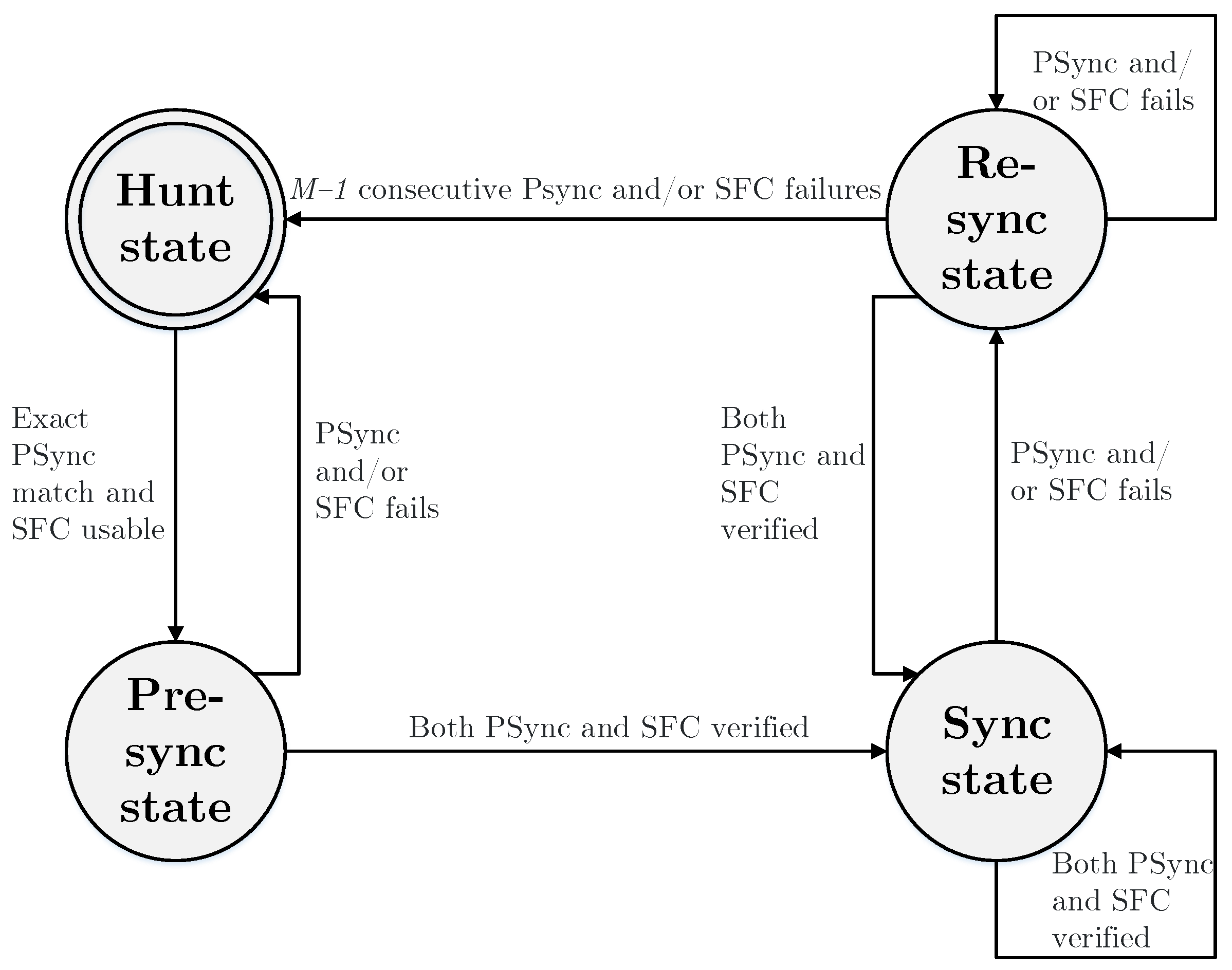
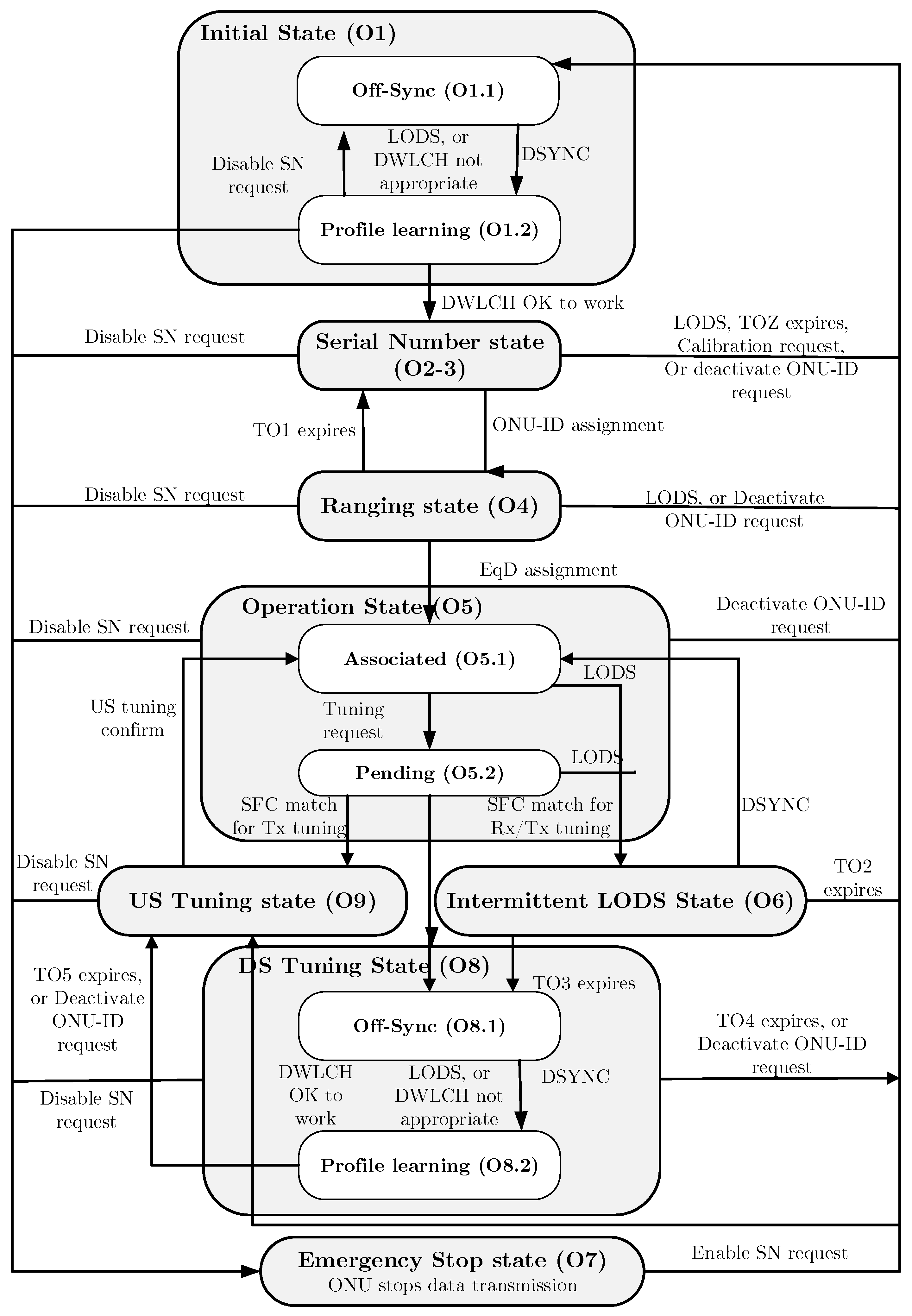
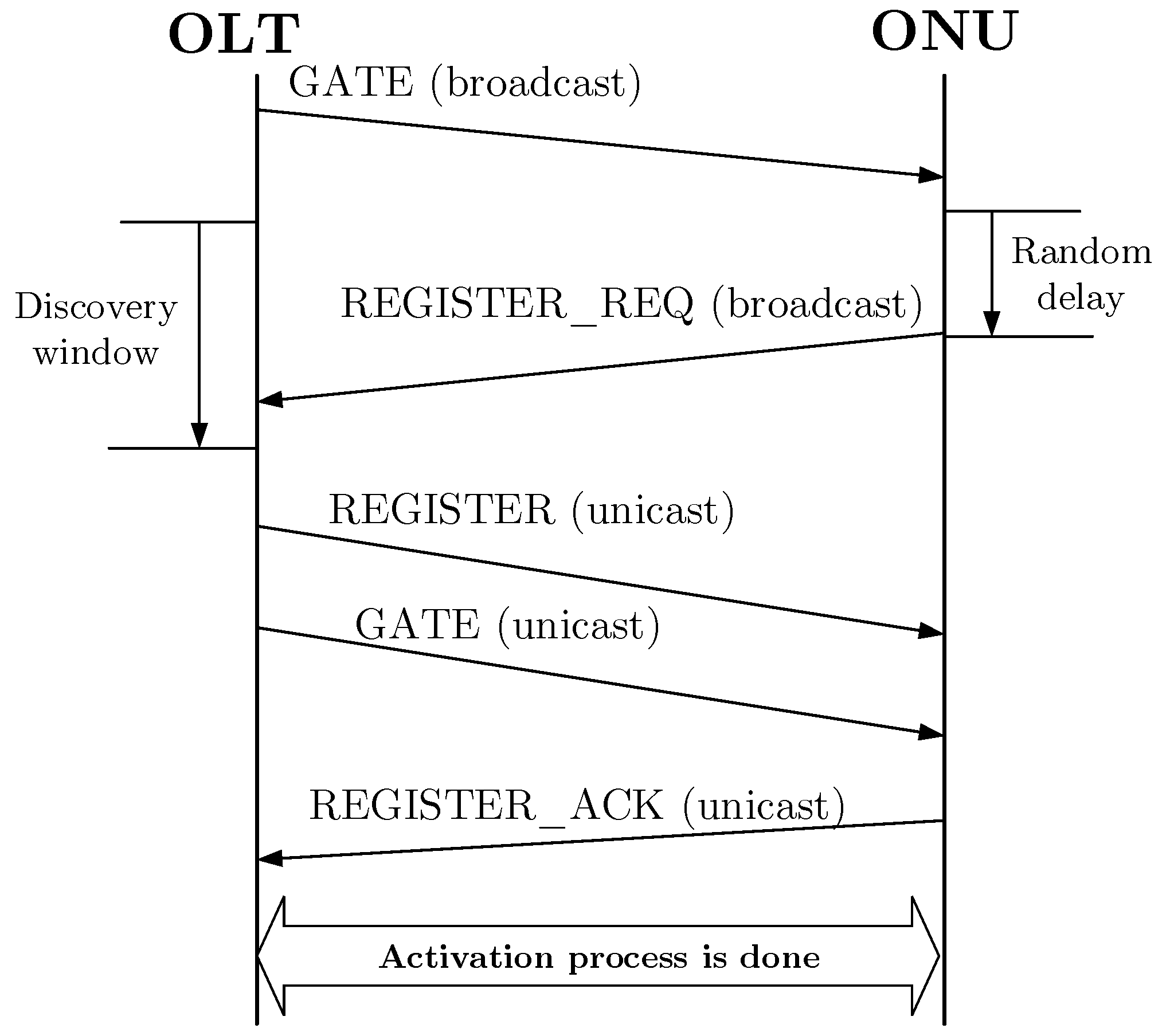

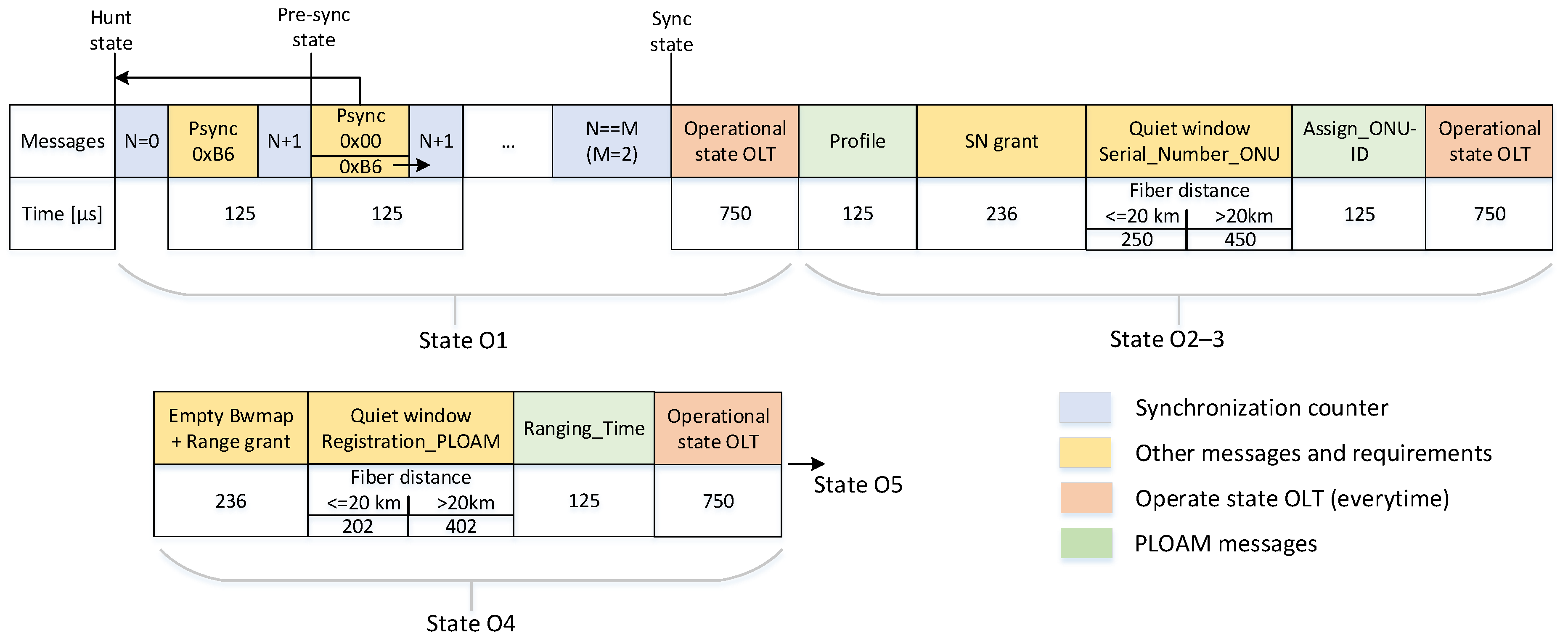
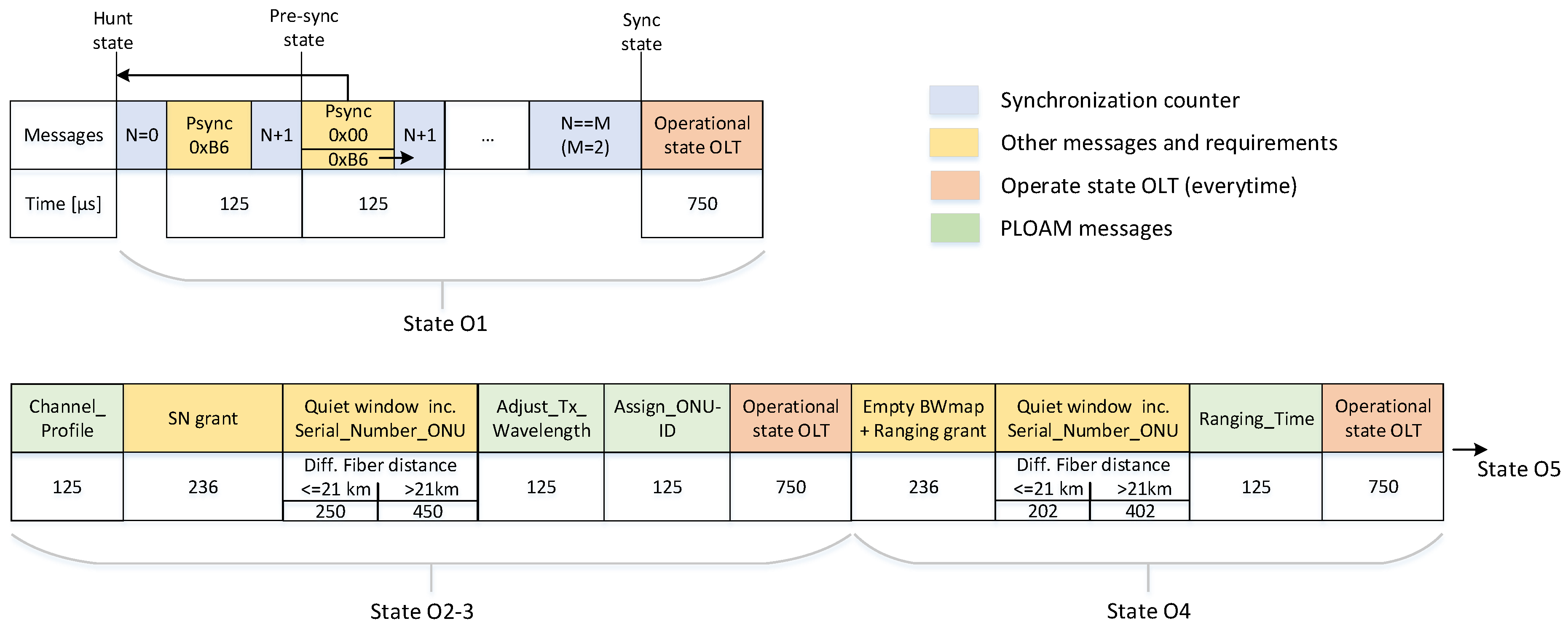




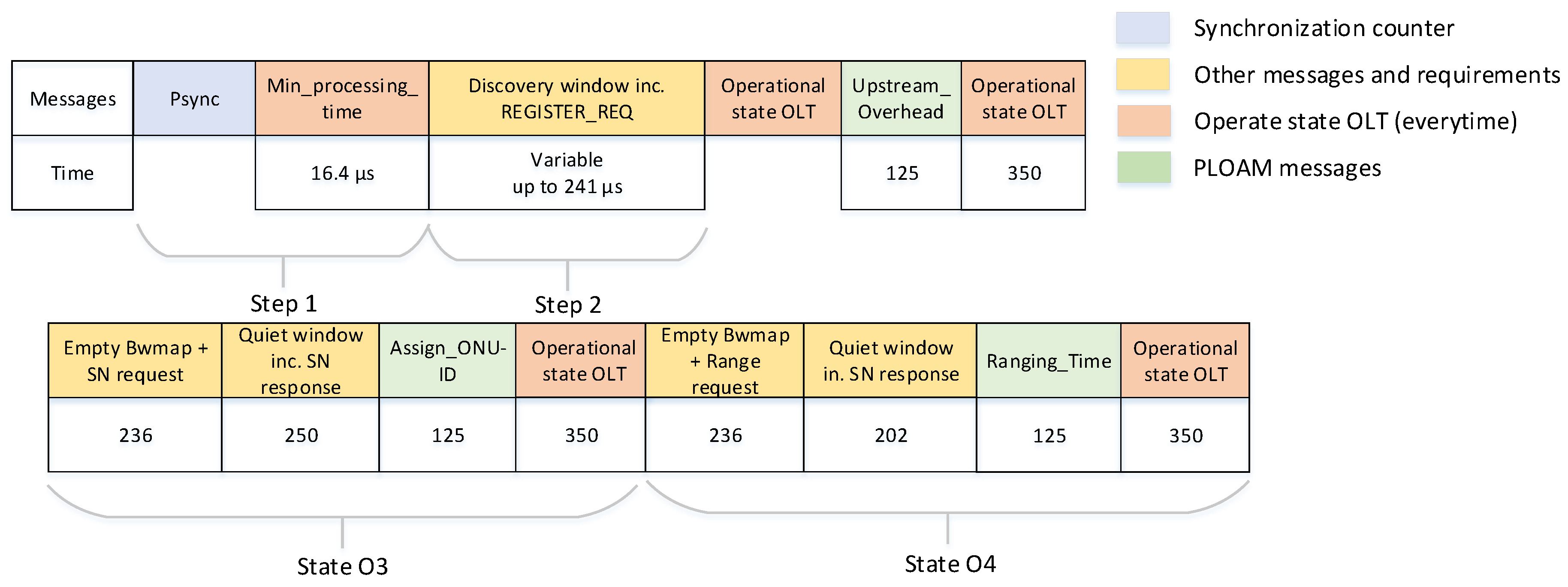
| Parameters | GPON | EPON (Type 2) |
|---|---|---|
| Standard | ITU-T G.984 | IEEE 802.3ah |
| Bitrate downstream | 1.244/2.488 Gbit/s | 1.25 Gbit/s |
| Bitrate upstream | 1.244/2.488 Gbit/s | 1.25 Gbit/s |
| for downstream | 1480–1500 nm | 1490 nm |
| for upstream | 1260–1360 nm | 1310 nm |
| Split ratio | 64 (up to 128) | 32 |
| Network reach | 20 km | 20 km |
© 2018 by the authors. Licensee MDPI, Basel, Switzerland. This article is an open access article distributed under the terms and conditions of the Creative Commons Attribution (CC BY) license (http://creativecommons.org/licenses/by/4.0/).
Share and Cite
Horvath, T.; Munster, P.; Oujezsky, V.; Vojtech, J. Activation Process of ONU in EPON/GPON/XG-PON/NG-PON2 Networks. Appl. Sci. 2018, 8, 1934. https://doi.org/10.3390/app8101934
Horvath T, Munster P, Oujezsky V, Vojtech J. Activation Process of ONU in EPON/GPON/XG-PON/NG-PON2 Networks. Applied Sciences. 2018; 8(10):1934. https://doi.org/10.3390/app8101934
Chicago/Turabian StyleHorvath, Tomas, Petr Munster, Vaclav Oujezsky, and Josef Vojtech. 2018. "Activation Process of ONU in EPON/GPON/XG-PON/NG-PON2 Networks" Applied Sciences 8, no. 10: 1934. https://doi.org/10.3390/app8101934
APA StyleHorvath, T., Munster, P., Oujezsky, V., & Vojtech, J. (2018). Activation Process of ONU in EPON/GPON/XG-PON/NG-PON2 Networks. Applied Sciences, 8(10), 1934. https://doi.org/10.3390/app8101934







